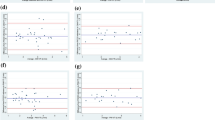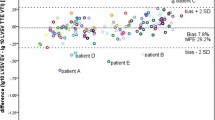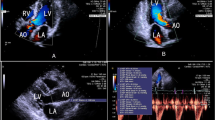Abstract
Introduction
Non-invasive hemodynamic monitoring may facilitate resuscitation in critically ill patients. Validation studies examining a transcutaneous Doppler ultrasound technology, USCOM-1A, using pulmonary artery catheter as the reference standard showed varying results. In this study, we compared non-invasive cardiac index (CI) measurements by USCOM-1A with transthoracic echocardiography (TTE).
Methods
This study was a prospective, observational cohort study at a university tertiary-care emergency department, enrolling a convenience sample of adult and pediatric patients. Paired measures of CI, stroke volume index (SVI), aortic outflow tract diameter (OTD), velocity time integral (VTI) were obtained using USCOM-1A and TTE. Pearson’s correlation and Bland–Altman analyses were performed.
Results
One-hundred and sixteen subjects were enrolled, with obtainable USCOM-1A CI measurements for 99 subjects (55 adults age 50 ± 20 years and 44 children age 11 ± 4 years) in the final analysis. Cardiac, gastrointestinal and infectious illnesses were the most common presenting diagnostic categories. The reference standard TTE measurements of CI, SVI, OTD, and VTI in all subjects were 3.08 ± 1.18 L/min/m2, 37.10 ± 10.91 mL/m2, 1.92 ± 0.36 cm, and 20.36 ± 4.53 cm, respectively. Intra-operator reliability of USCOM-1A CI measurements showed a correlation coefficient of r = 0.79, with 11 ± 22% difference between repeated measures. The bias and limits of agreement of USCOM-1A compared to TTE CI were 0.58 (−1.48 to 2.63) L/min/m2. The percent difference in CI measurements with USCOM-1A was 31 ± 28% relative to TTE measurements.
Conclusions
The USCOM-1A hemodynamic monitoring technology showed poor correlation and agreement to standard transthoracic echocardiography measures of cardiac function. The utility of USCOM-1A in the management of critically ill patients remains to be determined.
Similar content being viewed by others
References
Shure D. Pulmonary-artery catheters—peace at last? N Engl J Med. 2006;354:2273–4.
Chaney JC, Derdak S. Minimally invasive hemodynamic monitoring for the intensivist: current and emerging technology. Crit Care Med. 2002;30:2338–45.
Knirsch W, Kretschmar O, Tomaske M, et al. Cardiac output measurement in children: comparison of the Ultrasound Cardiac Output Monitor with thermodilution cardiac output measurement. Intensive Care Med. 2008;34:1060–4.
Wong LS, Yong BH, Young KK, et al. Comparison of the USCOM ultrasound cardiac output monitor with pulmonary artery catheter thermodilution in patients undergoing liver transplantation. Liver Transpl. 2008;14:1038–43.
Chan JS, Segara D, Nair P. Measurement of cardiac output with a non-invasive continuous wave Doppler device versus the pulmonary artery catheter: a comparative study. Crit Care Resusc. 2006;8:309–14.
van Lelyveld-Haas LE, van Zanten AR, Borm GF, Tjan DH. Clinical validation of the non-invasive cardiac output monitor USCOM-1A in critically ill patients. Eur J Anaesthesiol. 2008;25:917–24.
Knobloch K, Tepe J, Lichtinghagen R, Luck HJ, Vogt PM. Simultaneous hemodynamic and serological cardiotoxicity monitoring during immunotherapy with trastuzumab. Int J Cardiol. 2008;125:113–5.
Teoh WH, Sia AT. Colloid preload versus coload for spinal anesthesia for cesarean delivery: the effects on maternal cardiac output. Anesth Analg. 2009;108:1592–8.
Knobloch K, Hubrich V, Rohmann P, et al. Non-invasive determination of cardiac output by continuous wave Doppler in air rescue service. Anasthesiol Intensivmed Notfallmed Schmerzther. 2005;40:750–5.
Gunn SR, Fink MP, Wallace B. Equipment review: the success of early goal-directed therapy for septic shock prompts evaluation of current approaches for monitoring the adequacy of resuscitation. Crit Care. 2005;9:349–59.
Nguyen HB, Losey T, Rasmussen J, et al. Interrater reliability of cardiac output measurements by transcutaneous Doppler ultrasound: implications for noninvasive hemodynamic monitoring in the ED. Am J Emerg Med. 2006;24:828–35.
Stewart GM, Nguyen HB, Kim TY, Jauregui J, Hayes SR, Corbett S. Inter-rater reliability for noninvasive measurement of cardiac function in children. Pediatr Emerg Care. 2008;24:433–7.
Dey I, Sprivulis P. Emergency physicians can reliably assess emergency department patient cardiac output using the USCOM continuous wave Doppler cardiac output monitor. Emerg Med Australas. 2005;17:193–9.
Critchley LA, Critchley JA. A meta-analysis of studies using bias and precision statistics to compare cardiac output measurement techniques. J Clin Monit Comput. 1999;15:85–91.
McGee S, Abernethy WB III, Simel DL. The rational clinical examination. Is this patient hypovolemic? JAMA. 1999;281:1022–9.
Schedler O, Handschak H, Hensel M. Non-invasive cardiac output measurement with USCOM in air rescue operation. Ultraschall Med. 2008;29(Suppl 5):256–9.
Knobloch K. Non-invasive determination of stroke volume and cardiac output after high intensity playing exercise in elite female soccer players. Int J Cardiol. 2009;132:267–9.
Corley A, Barnett AG, Mullany D, Fraser JF. Nurse-determined assessment of cardiac output. Comparing a non-invasive cardiac output device and pulmonary artery catheter: a prospective observational study. Int J Nurs Stud. 2009;46:1291–7.
Dark PM, Singer M. The validity of trans-esophageal Doppler ultrasonography as a measure of cardiac output in critically ill adults. Intensive Care Med. 2004;30:2060–6.
Nidorf SM, Picard MH, Triulzi MO, et al. New perspectives in the assessment of cardiac chamber dimensions during development and adulthood. J Am Coll Cardiol. 1992;19:983–8.
Siu L, Tucker A, Manikappa SK, Monagle J. Does patient position influence Doppler signal quality from the USCOM ultrasonic cardiac output monitor? Anesth Analg. 2008;106:1798–802.
Robson SC, Murray A, Peart I, Heads A, Hunter S. Reproducibility of cardiac output measurement by cross sectional and Doppler echocardiography. Br Heart J. 1988;59:680–4.
Yajima T, Nitta M, Nakamura S, et al. Reliability of Doppler echocardiographic stroke volume measurement. Bull Tokyo Med Dent Univ. 1992;39:55–62.
Marik PE, Baram M, Vahid B. Does central venous pressure predict fluid responsiveness? A systematic review of the literature and the tale of seven mares. Chest. 2008;134:172–8.
Pinsky MR. Functional hemodynamic monitoring. Intensive Care Med. 2002;28:386–8.
Michard F, Teboul JL. Predicting fluid responsiveness in ICU patients: a critical analysis of the evidence. Chest. 2002;121:2000–8.
Knobloch K, Tepe J, Rossner D, et al. Combined NT-pro-BNP and CW-Doppler ultrasound cardiac output monitoring (USCOM) in epirubicin and liposomal doxorubicin therapy. Int J Cardiol. 2008;128:316–25.
Siu CW, Tse HF, Lee K, et al. Cardiac resynchronization therapy optimization by ultrasonic cardiac output monitoring (USCOM) device. Pacing Clin Electrophysiol. 2007;30:50–5.
Sturgess DJ, Pascoe RL, Scalia G, Venkatesh B. A comparison of transcutaneous Doppler corrected flow time, b-type natriuretic peptide and central venous pressure as predictors of fluid responsiveness in septic shock: a preliminary evaluation. Anaesth Intensive Care. 2010;38:336–41.
Trinkmann F, Doesch C, Papavassiliu T, et al. A novel noninvasive ultrasonic cardiac output monitor: comparison with cardiac magnetic resonance. Clin Cardiol. 2010;33:E8–14.
Thom O, Taylor DM, Wolfe RE, et al. Comparison of a supra-sternal cardiac output monitor (USCOM) with the pulmonary artery catheter. Br J Anaesth. 2009;103:800–4.
Phillips R, Lichtenthal P, Sloniger J, Burstow D, West M, Copeland J. Noninvasive cardiac output measurement in heart failure subjects on circulatory support. Anesth Analg. 2009;108:881–6.
Saur J, Trinkmann F, Weissmann J, Borggrefe M, Kaden JJ. Non-invasive determination of cardiac output: comparison of a novel CW Doppler ultrasonic technique and inert gas rebreathing. Int J Cardiol. 2009;136:248–50.
Su B, Yu H, Yang M, et al. Reliability of a new ultrasonic cardiac output monitor in recipients of living donor liver transplantation. Liver Transpl. 2008;14:1029–37.
Van den Oever HL, Murphy EJ, Christie-Taylor GA. USCOM (Ultrasonic Cardiac Output Monitors) lacks agreement with thermodilution cardiac output and transoesophageal echocardiography valve measurements. Anaesth Intensive Care. 2007;35:903–10.
Chand R, Mehta Y, Trehan N. Cardiac output estimation with a new Doppler device after off-pump coronary artery bypass surgery. J Cardiothorac Vasc Anesth. 2006;20:315–9.
Tan HL, Pinder M, Parsons R, Roberts B, van Heerden PV. Clinical evaluation of USCOM ultrasonic cardiac output monitor in cardiac surgical patients in intensive care unit. Br J Anaesth. 2005;94:287–91.
Knobloch K, Lichtenberg A, Winterhalter M, Rossner D, Pichlmaier M, Phillips R. Non-invasive cardiac output determination by two-dimensional independent Doppler during and after cardiac surgery. Ann Thorac Surg. 2005;80:1479–83.
Critchley LA, Peng ZY, Fok BS, Lee A, Phillips RA. Testing the reliability of a new ultrasonic cardiac output monitor, the USCOM, by using aortic flowprobes in anesthetized dogs. Anesth Analg. 2005;100:748–53.
Acknowledgments
This study was partially funded by USCOM Pty Ltd, Australia. USCOM Pty Ltd did not participate in the study design or decision to submit the manuscript for publication.
Author information
Authors and Affiliations
Corresponding author
Additional information
Nguyen HB, Banta DP, Stewart G, Kim T, Bansal R, Anholm J, Wittlake WA, Corbett SW. Cardiac index measurements by transcutaneous Doppler ultrasound and transthoracic echocardiography in adult and pediatric emergency patients.
Rights and permissions
About this article
Cite this article
Nguyen, H.B., Banta, D.P., Stewart, G. et al. Cardiac index measurements by transcutaneous Doppler ultrasound and transthoracic echocardiography in adult and pediatric emergency patients. J Clin Monit Comput 24, 237–247 (2010). https://doi.org/10.1007/s10877-010-9240-6
Received:
Accepted:
Published:
Issue Date:
DOI: https://doi.org/10.1007/s10877-010-9240-6




